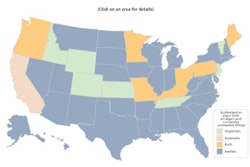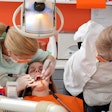
To the new classes of dental professional cropping up around the U.S., add one more: California's registered dental assistants in extended function 2 (RDA-EF2), who may have the widest scope of duties of any dental assistants in the country.
Starting January 1, the new category of assistants can place all types of restorations -- direct and indirect, alloy and composite -- and even endodontic points. In short, they can do anything a dentist does to restore a tooth except administer anesthesia and remove tooth structure.
“I've been waiting for this for 20 years.”
— Serene Hermann, RDA-EF,
Martinez, CA
"I'm very excited," said Serene Hermann, a Martinez, CA, dental assistant who is already an RDA EF and is looking forward to adding the number 2 to her degree, indicating the further expansion of her scope of practice. "I've been waiting for this for 20 years."
Currently, the 1,400 RDA-EFs in the state can take impressions and place provisional crowns but not permanent restorations. Two schools in California are offering courses for the new degree: the University of California, Los Angeles and Sacramento City College.
Additional hours
The new scope of practice doesn't come easily. To become an RDA, you have to complete a series of courses and pass an exam. If you then want to add extended functions, you must take an additional 388 hours of instruction and pass an exam. Current RDA-EFs who want to become RDA-EF2s will have to take 280 additional hours and pass the exam.
Around the country, the scope of dental assistants' practice varies widely from states like Utah, which forbids them to place any type of restoration, to Ohio, which expressly allows most of what the California RDA-EF2s can do, except place endodontic points.
 |
| Click here to view this image. |
| Interactive map of restorative duties by state for hygienists and assistants. |
The list of states allowing hygienists to do restorations is longer. According to the American Dental Hygienists' Association, Colorado, New Jersey, and Washington allow hygienists to place temporary crowns and fillings and permanent amalgam and composite resin fillings. Hawaii, Texas, Utah, Louisiana, and Delaware, on the other hand, bar hygienists from all of these procedures. Most of the other states allow some restorative work, but not all. (Some states neither explicitly forbid nor allow auxiliaries to perform restorative procedures, leaving their scope of duties open to interpretation.)
The new California program came about after a long tussle with dentists in the state, said Barbara Blade, RDA-EF, program coordinator of the UCLA program. "They fought us for 25 years," she said. "Without the support of the CDA (California Dental Association), it would not have happened."
What changed? "Access to care is very important in California," Blade said. "California is going to experience a shortage" of dental professionals.
But the bigger factor was self-interest, she said. "They saw how well trained we were and they started to see the advantages. A doctor can double the amount of work he does."
Dean Chalios, CDA vice president for policy, agreed that dentistry will benefit from the new program. "It will clearly provide dentists with an opportunity to increase the care they provide in their offices and clinics," he said. "We worked very closely with the dental assisting community and consider them partners to a large extent. It allows dental offices to be more efficient and utilize the whole team."
He expects more dentists to practice "four-handed dentistry," in which dentists rely on assistants to do a larger portion of the work they traditionally do.
Hygienists' support
California will now be the only state that allows assistants to place both types of permanent filling, but doesn't allow that privilege to hygienists. Still, Lygia Joley, vice president of the California Dental Assistants Association, said hygienists in the state support the new role for assistants.
"We support any step up, so long as it requires proper education and proper testing," she said.
Some hygienists may study to become RDA-EF2s, Joley added. Then they could anesthetize the patient, the doctor could come in to prepare the tooth, and then the RDH RDA-EF2 could place the restoration.
"We would like to be able to expand the role of hygienists," she said. "We don't have the education program, and we can't get a school to do it at this point. That's where the politics come into play."
Herrmann will work under George W. Swanson, D.D.S., who was enthusiastic about the work she will be able to do in his office. "After 25 years, a dentist doesn't want to spend time on fillings," he said. "Her restorations are pretty great."
But he also expressed uncertainty about the new class of dental professional in general. "It could be abused," he said. "It could open a can of worms. Or it could allow dentist to utilize their staff more efficiently."
Copyright © 2009 DrBicuspid.com



















